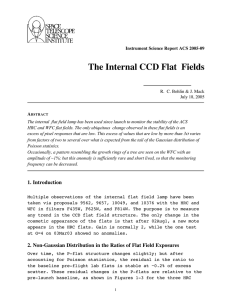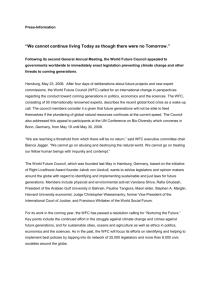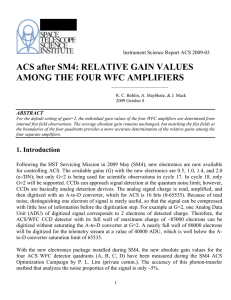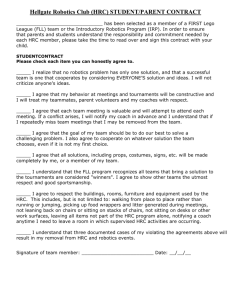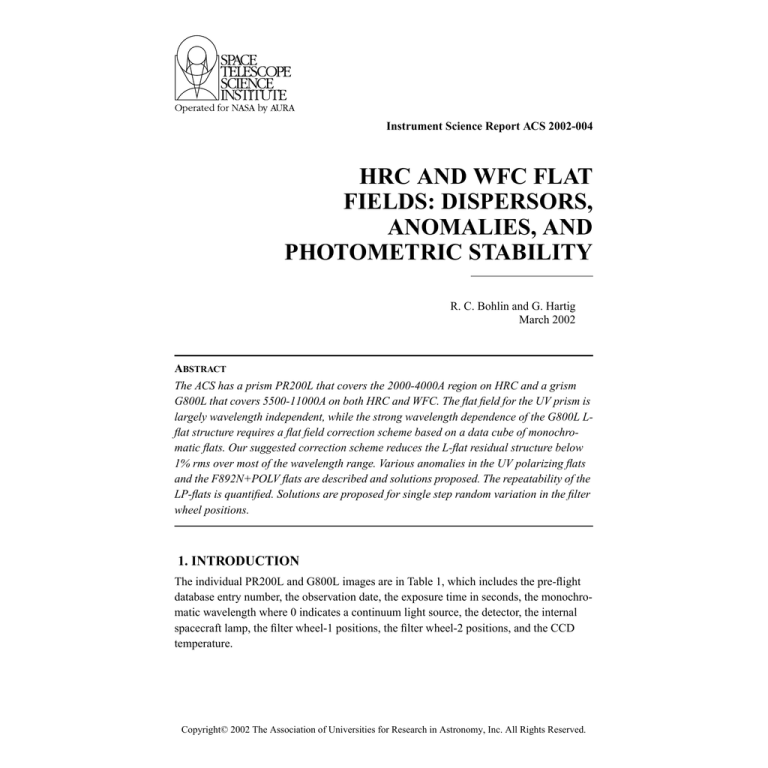
Instrument Science Report ACS 2002-004
HRC AND WFC FLAT
FIELDS: DISPERSORS,
ANOMALIES, AND
PHOTOMETRIC STABILITY
R. C. Bohlin and G. Hartig
March 2002
ABSTRACT
The ACS has a prism PR200L that covers the 2000-4000A region on HRC and a grism
G800L that covers 5500-11000A on both HRC and WFC. The flat field for the UV prism is
largely wavelength independent, while the strong wavelength dependence of the G800L Lflat structure requires a flat field correction scheme based on a data cube of monochromatic flats. Our suggested correction scheme reduces the L-flat residual structure below
1% rms over most of the wavelength range. Various anomalies in the UV polarizing flats
and the F892N+POLV flats are described and solutions proposed. The repeatability of the
LP-flats is quantified. Solutions are proposed for single step random variation in the filter
wheel positions.
1. INTRODUCTION
The individual PR200L and G800L images are in Table 1, which includes the pre-flight
database entry number, the observation date, the exposure time in seconds, the monochromatic wavelength where 0 indicates a continuum light source, the detector, the internal
spacecraft lamp, the filter wheel-1 positions, the filter wheel-2 positions, and the CCD
temperature.
Copyright© 2002 The Association of Universities for Research in Astronomy, Inc. All Rights Reserved.
Instrument Science Report ACS 2002-004
2. PR200L
2.1 L-flat
The prism PR200L was illuminated by continuum radiation from a deuterium lamp using
the RAS/CAL optical simulator, as described in section 3 of Paper I (Bohlin, Hartig, &
Martel 2001). The deuterium RAS/CAL illumination is not the same as the high fidelity
RAS/HOMS and tungsten lamp that are used to define the LP-flats at longer wavelengths.
In Paper I, the ratio image D/T of the deuterium RAS/CAL to the tungsten RAS/HOMS
flat fields at F435W provided a correction to the four UV flats obtained with the RAS/
CAL. Unfortunately, this same D/T correction is not applicable to the PR200L RAS/CAL
flat because of the shift on the CCD of the illuminating field by the dispersing prism. Fortunately, the shift is in the direction toward the right edge, so that a lot of the poor
illumination pattern is shifted out of the PR200L field of view. Since the HRC UV L-flat
fields from F220W to F435W are all identical to <5% (Paper I), the PR200L flat can be
compared to the baseline RAS/HOMS F435W LP-flat in order to estimate errors in the
PR200L L-flat. Figure 1 shows the PR200L flat, while Figure 2 shows its predicted error,
PR200L/F435W, from the comparison with the baseline F435W. The predicted L-flat error
of <5% along the center line, which is typical of the left hand half of the flat, is compared
to the error along the right edge. The predicted L-flat error exceeds 10% only for a small
region in the lower right corner. From a comparison of the baseline flats for F220W and
F330W, the PR200L L-flat should wavelength independent to <3% over most of its wavelength range.
2.2 P-flat
The only data relevant to the wavelength dependence of the P-flat is provided by the LPflats for the four UV filters, F220W, F250W, F330W, and F344N, which span most of the
2000-4000A coverage of PR200L. After applying the deuterium PR200L flat to the four
UV filters, the residual rms pixel-to-pixel scatter in the standard 101x101 pixel box is only
0.3-0.4% after removing the contribution of the counting statistics. Since there are no
monochromatic flats for PR200L itself, the best estimate of intermediate scale errors in
using the continuum PR200L flat for all wavelengths is provided by comparing F220W
and F330W, as shown in Figure 3. Only the 25x15 pixel blemish at the top center shows
more than a 5% different sensitivity in F220W than in F330W. In total, there are only
~1100 px with >5% lower sensitivity and no pixels with >5% higher sensitivity in F220W
compared to F330W.
In summary, the deuterium continuum illumination of PR200L provides an adequate LPflat field for most astronomical observations, especially after the low frequency L-flat is
updated with calibration observations after launch.
2
Instrument Science Report ACS 2002-004
3. G800L
In contrast to the prism flats on the SBC and the HRC, the wavelength dependence of the
flat field is a serious problem for G800L observations. In principle, a data cube of monochromatic flats covering the 5500-11000A range of the G800L spectra could be the basis
for a pixel-by-pixel correction scheme once the wavelengths of each pixel in a spectrum
are assigned. The data cube would be the flat field value as a function of wavelength and
x,y pixel position. Unfortunately, this data cube cannot be populated directly because of
strong fringing in monochromatic light beyond 7000-7500A. However, the change in the
LP-flat field structure is a weak enough function of wavelength, such that adequate LPflats can be constructed for most of the 5500-11000A sensitivity range of G800L by substituting broadband flats for monochromatic flats. In particular, the six high S/N white
light flats listed in Table 2 along with their assigned effective wavelengths define a flat
field data cube for G800L spectra on HRC and WFC.
3.1 How Well does the Data Cube Reproduce Monochromatic Flats?
As demonstrated in Paper I, the monochromatic LP-flats at the shorter wavelengths are
nearly identical to white light flats in the same filter. The statistics for the standard
101x101 pixel areas defined in Paper I appear in Tables 3 and 4 and show that the adjacent
flats in Table 2 have nearly the same P-flat structure. Only the two cases for HRC with the
biggest wavelength separation, F658N/F775W and F814W/F850LP, have rms residuals as
large as 0.5%; and those residuals are inflated by L-flat gradients within the 101x101 px
box. Therefore, the P-flat structure in G800L spectra is adequately removed by an LP-flat
for each wavelength that is either the nearest neighbor or is interpolated from the data
cube.
The change in the L-flat structure with wavelength is more problematic than the variation
in the P-flats. For the 5500-11000A sensitivity range of G800L, Figures 4 and 5 show the
change in the L-flat structure for 1% of the field area near the bottom right corner of the
HRC flats and in the blob region for WFC. The flats F550M, F625W, and F660N are plotted in the Figures 4-5 but are not included in the data cube, because the density of flats
below 6600A is sufficient, because F625W appears to have a small bandpass irregularity
in one corner, and because F660N has two strong dust mote signatures on the WFC chip 1.
Since the Figures 4-5 suggest that an interpolation with wavelength in the data cube could
provide a good LP-flat for any wavelength, Figures 6-7 compare the rms values of the
intrinsic L-flat structure to the residual L-flat errors for monochromatic light. The residuals are the remaining low frequency structure after applying the data cube in two different
ways: by choosing the nearest neighbor and by interpolating a L-flat. In order to minimize
the effect of fringing, the L-flat residuals are the rms scatter in coarsely binned images, as
computed by plotLflat.pro. The HRC is binned into 16x16 boxes, while the WFC chip 1 is
binned 32x16. The bins around the outside are omitted in the rms, so that 14x14 and
30x14 bins are used to compute the 1-sigma values for HRC in Figure 6 and WFC in Fig-
3
Instrument Science Report ACS 2002-004
ure 7, respectively. The monochromatic flat at 8250A on WFC in Figure 7 shows the most
improved L-flat residuals from 1% for the nearest neighbor F814W flat to 0.4% for an
interpolated flat. Figure 8 shows the smoothed L-flat residuals for this monochromatic
8250A flat vs. the white light F814W flat, while Figure 9 shows 8250A vs. the interpolated flat. The interpolated 8250A flat produces L-flat errors of <1% everywhere, while
the nearest neighbor F814W correction in Figure 8 shows +-2% residuals in the blob
region and the surrounding ring on a scale size that is large compared to the fringe pattern.
In summary, monochromatic LP-flats can be synthesized below ~9200A to better than
~0.5% in the P-flat and to 1% precision in the L-flat. The application of these monochromatic flats that are interpolated from our data cube of white light LP-flats might improve
the accuracy of the models of the G800L fringing pattern that are developed at the European Coordinating Facility. In any case, L-flat residuals for G800L spectra are
substantially reduced by using our data cube to estimate monochromatic LP-flats.
3.2 Monochromatic Flats for G800L
Monochromatic flats derived from the broadband filters of our data cube are not directly
appropriate for G800L, since G800L L-flats are vignetted at the long and short wavelength
edges by up to ~10%. If the change with wavelength of the G800L monochromatic flats is
the same as the change with wavelength on broadband filters, then monochromatic LPflats for G800L can be made from the broadband data cube by multiplying by the high S/N
ratio between the pair of monochromatic flats taken through both G800L and the F625W
broadband filter, viz. 6301A for HRC and 6320A for WFC. In addition to the vignetting,
the dust motes on the detector window are up to ~5% different because of the different
angles of illumination, as illustrated for the worse case of HRC in Figure 10.
4. ANOMALIES
The POL flats for WFC are taken as individual subarrays for the small POL filter position
at the default location on each chip. The illuminating lamp brightness changes slowly with
time; and the chip 1 and 2 flat field observations for each filter combination were obtained
at different times. Therefore, each subarray flat is normalized separately to its central
value and not to the chip 1 center, as is done for the full frame WFC flats, where both chips
are exposed simultaneously.
4.1 Spurious Glints on WFC POLV
The small filter F892N with the POLV filters on the WFC chip 2 displays an anomalous
bright patch that differs from the normal, more uniform pattern observed for the same
combination on chip 1. Apparently, there is some stray light for this case that may be a
result of a glint off some shiny surface on one of the filter wheels. The problem is so bad
for POL120V that the F892N+POL120V, chip 2 flat must be normalized off center by 300
4
Instrument Science Report ACS 2002-004
pixels in both x and y. The F850LP+POLV flats on chip 2 show a similar glint, except that
all three polarization angles are about equally bad. F892N+POLV and F850LP+POLV
observations should always utilize the chip 1 aperture, since the chip 2 flats are unreliable.
4.2 Central Brightening for Pol UV
Lab flats on each CCD chip for F435W, F660N, and F814W with each of the three polarization angles, 0, 60 and 120deg were obtained for a total of 9 HRC and 18 WFC flats, as
enumerated in Tables 3-4 of Paper I. The HRC flats with and without the polarizer are the
same to <3%, while the WFC POLUV LP-flats show a 10-40% central enhancement in the
L-flat structure, as shown in Figure 11. While there is no reason to expect that our flats are
wrong for an extended source such as the Orion Nebula or even for the sky, the anomalous
lab flats are probably inappropriate for sparse star fields. The central bright spot is worse
for F660N, which reflects a larger fraction of the incident light than the broader band
F435W and F814W. The problem might be due to multiple reflection between the wheel 2
filter and the wheel 1 polarizer. In this case, there may be stellar ghosts on WFC images
with the POLUV polarizers in the beam. GO observations with WFC+POLUV should be
avoided until the L-flat calibration star field is observed.
5. STABILITY
Over the Feb-Nov 2001 time period, several internal and external flats were repeated to
check the stability of the LP-flats. The P-flat structure is stable on both CCD cameras to
0.1%, i.e. to the statistical significance of a million counts. In general, the observed
changes in the L-flat structure is <1%. One exception is the internal HRC flats, where a
5% drop is seen along the top edge on day 93 (April 3) in 2001. This instability may be
attributed to a bounce of the HRC fold mechanism off its mechanical stop, which is now
avoided by a patch to the flight software that was installed on 2001 July 2 (day 183). Since
the anomalous day 93 flats were obtained in a different orientation than the other HRC
data, gravity may also play a role. After July 2, all internal HRC flats in Table 5 were taken
in the same orientation as the original set from days 60-61 and show only an occasional
~2% instability that is confined to the upper left corner and to a small spot near the bottom
right corner. The external RAS/CAL deuterium flats (Paper I) are in the same orientation
as the day 93 internal flats but do not have the anomalous drop at the top.
These same <0.1 and <1% levels of LP-flat stability are measured for a change in CCD
temperature of 2C for the internal illumination of F435W. The fringe pattern for external
monochromatic 9200A light is stable to 0.5% rms per 2C (Paper I).
5.1 P-flat Internal Baseline Flats
The internal flats listed in Table 5 provide a baseline for comparison to internal flats
obtained in orbit. All of the possible choices are included, so that the best match can be
5
Instrument Science Report ACS 2002-004
found for zero gravity and for the actual on-orbit operating temperature. The internal flats
provide a good measure of the P-flat stability; but the mote features are blurred, since the
angular spread in the illuminating light beam is larger for the internal lamp than for external OTA illumination. Any systematic change in these internal flats can provide an onorbit delta P-flat for correcting our set of lab LP-flats.
5.2 Moving Dust
One major lien on the applicability of our lab flats to flight data is the stability of the dust
motes. During the flight level acoustic test on 2001 March 23, one strong mote centered at
(671,617) with a full width of ~40px and a depth of ~10% disappeared from the HRC
detector window, while one weak (<1%) mote moved on WFC. Since there is no colocated sharp L-flat feature, the LP-flats from the Feb-Mar time frame can be patched with
internal flats taken after the acoustic test. In particular, the HRC rectangle with pixel index
zero location (652:690,596:638) can be cut from on-orbit internal flats and pasted into the
pipeline flats. For F892N with its fringe pattern in white light, the patch from the internal
flat will not be perfect. Hopefully, launch will not cause more particulate migrations,
because the internal flats blur the mote shadows and do not provide proper patches for
OTA illumination of new motes.
5.3 Single Step Non-repeatability of the Filter Wheels
The typical positioning accuracy of the filter wheel is within +- one motor step of the nominal position. This delta corresponds to a distance on the detectors of 18 HRC pixels and
25 WFC pixels. Features with sharp transmission gradients at the filter wheels cause a corresponding flat field instability. One example is the set of small polarizing filters where the
filter edge is imaged on the WFC. Any source within 1-2 steps (25-50 px) of the filter edge
will be unreliable, unless the flat field for the exact wheel step is applied.
Other examples of sharp features are the dust contamination on the filters and the bubbles
in the optical cement used to bond the two components of the POLV filters. The worst of
these blemishes are in the POL0V and POL60V filters with a variation in the flat field of
+- 3% across the feature as shown in Figures 8-9 of Paper I for POL0V. Figure 12 illustrates the correction of a POL60V flat with another POL60V flat that is off by one filter
wheel mechanism step. Errors typically reach +- 2% in the black and white regions and are
as high as 3% for a few pixels. A two step wheel offset is slightly worse with more errors
that exceed 2%. Figure 13 is the ratio of two flats at the same filter wheel position, where
the L-flat residuals rarely exceed the 0.3% specification goal. The POL0V filter defects are
almost as bad as the POL60V; and the flat fielding errors associated with a one step misalignment are similar on the WFC and HRC.
6
Instrument Science Report ACS 2002-004
5.4 Flat Fields for Filter Wheel Offset Positions
Because of the one step repeatability of the filter wheels, RAS/HOMS flat fields at three
adjacent step positions were obtained in 2001 November for the filters with the worst
blemishes, viz. the POL0V and POL60V in combination with three broadband filters,
F475W, F606W, and F775W. In order to obtain the required 0.2-0.3% statistical precision,
36 HRC images and 108 WFC subarray images were taken, along with 9 full field images
of F606W alone on WFC. After combining the WFC chip-1 and chip-2 subarrays into one
file, 18 HRC and 21 WFC flat fields now provide a full set of flats for the three possible filter wheel step positions. Since the resolver position (JFW1POS or JFW2POS) uniquely
determines the filter wheel step, the ACS pipeline data processing should be enhanced to
automatically apply the proper flat for the wheel step position. In the meanwhile, the zero
offset, nominal position flats from the new November sets replace the Paper I, 2001 February flats for these six HRC and 7 WFC flat fields.
5.5 Alternative Correction for Wheel Position Errors
Can the other filters with strong dust motes and the other filter combinations with POL0V
and POL60V be corrected for filter wheel position errors? One possibility is to isolate the
contribution of the mote and to shift its position in the flat field. Since the P-flat features
vary little with wavelength, a blemish can be isolated by dividing by a flat that is nearby in
wavelength. The accuracy of this technique is tested for the case illustrated in Figure 12, in
order to compare with the more straightforward result in Figure 13. The P-flat, the detector
features, and the F606W motes are removed by dividing the 2001 Feb F606W+POL60V
flat by the baseline F606W flat. A template blemish is isolated in a circle of radius 178
pixels, centered at (831,430). The underlying flat is modeled by the F606W flat within this
circle. To produce a flat for the offset of +1 step, the template blemish is shifted -18px in x
and -6px in y and multiplied by the original F606W+POL60V flat that has the circular
inset F606W flat to produce the model flat at the offset position. Figure 14 is the result of
correcting the flat at +1 step obtained in 2001 Nov by our model and can be compared
directly to Figure 13, which is the ratio of exactly aligned, observed flat fields. In the
region of the major blemish, the modeled flat in Figure 14 corrects an observation nearly
as well as the observed flat used in Figure 13. The white crescent at the lower left of the
blemish represents a ~0.7% error and is caused by a slight transmission non-uniformity of
the polarizing filter that makes a localized discontinuity between the actual
F606W+POL60V flat and the underlying model F606W in that region. With additional
effort, the amplitude of the crescent error could be reduced.
REFERENCES
Bohlin, R. C., Hartig, G., & Martel, A. 2001, Instrument Science Report, ACS 01-11,
Paper I, (Baltimore:STScI).
7
Instrument Science Report ACS 2002-004
Figures
Figure 1: LP-flat for PR200L on HRC, as illuminated with a continuum deuterium lamp.
The grey scale calibration is indicated on the reference bar at the top right. All images displayed and discussed in this paper are in the standard GO coordinate system of the pipeline data products. The filter 1 and 2 names are the second line of text at the top. The next
line of text “rms(%)=” indicates one-sigma values in the 101x101 pixel standard region
(dashed box) for the total pixel-to-pixel scatter, the Poisson counting statistic, and the
intrinsic rms variation of the flat. The fourth line of text is the file name, which includes an
h for HRC, e for external illumination, 01235 for the date of observation: day 235 in 2001,
sm02 for the sum of 2 images taken for cosmic ray rejection, and the filter name pr200l.
The shift of the field of view by the prism is evident by the vignetted image of a baffle at
the left side of the flat. This unilluminated portion of the field below 0.8 and the Fastie finger area are masked to unity.
ACS HRC
CLEAR1S PR200L
rms(%)= 0.60 0.30 0.52
lphe01235sm02pr200l
0.900
1.050
Bohlin: prtimg 21-Dec-2001 12:34
8
9
Predicted Error of Lab PR200L L-flat
1.2
1.1
1.0
0.9
0
200
400
600
Pixels from Bottom
Bohlin: pr200lerr 20-Dec-2001 13:10
800
1000
Instrument Science Report ACS 2002-004
Figure 2: Predicted error in the PR200L L-flat for vertical cuts along the right hand edge (solid line) and at the center (dotted line) of
the ratio image PR200L/F435W. Pixel zero is at the bottom of the flat fields, which are always in the standard GO coordinate system.
Observations of a standard star field at various locations in the field of view can provide verification of our predictions.
Instrument Science Report ACS 2002-004
Figure 3: Ratio of the F220W to F330W flats demonstrating the small changes in the LPflat over most of the sensitivity range of PR200L.
ACS HRC RATIO
CLEAR1S F220W / CLEAR1S F330W
rms(%)= 0.54 0.48 0.24
xleft=395
lphe01235sm02f220w / lphe01235sm02f330w
0.950
1.050
Bohlin: prtimg 20-Dec-2001 16:47
10
Instrument Science Report ACS 2002-004
Figure 4: L-flat value for HRC averaged over 0.1x0.1=0.01 or 1% of the area of the flat fields as function of wavelength. The open triangles are monochromatic flats, while the small filled squares are the L-flat values for the broadband filters in continuum light. The
small squares are plotted at the wavelength in the filter name; and the large open squares are at the effective filter wavelengths in Table
2, which are determined by the shift required to bring the white light L-flat value into agreement with the monochromatic locus of
points. The center of the L-flat patch is located 15% of the field size from the lower right hand corner in both X and Y.
11
Instrument Science Report ACS 2002-004
Figure 5: As in Figure 4 for WFC, except that the location is at the blob, which is near the bottom of chip 1 centered at x=0.39 of the
field size and which has the greatest variation in sensitivity with wavelength.
12
Instrument Science Report ACS 2002-004
Figure 6: L-flat rms scatter for monochromatic flat fields on HRC in 14x14 boxes for the intrinsic variation with no flat (heavy line with
circles), after applying the nearest neighbor broadband flat field (open triangles), and for interpolated flat fields (filled squares). The set
of circles also includes the broadband flats, which are plotted at their effective wavelengths from Table 2. The interpolated flats are
never worse than the nearest neighbor; but the improvement is, at most, only from 0.9 to 0.6% at 8630A. Beyond 9100A the interpolation scheme becomes an extrapolation; and because of the rapidly changing L-flat structure with wavelength, the residuals show a steep
increase for both the nearest neighbor (F850LP) and for extrapolation. However, dividing by a flat field reduces the intrinsic L-flat
structure by at least 2x, and by up to 10x at the shortest wavelengths.
13
Instrument Science Report ACS 2002-004
Figure 7: As in Figure 6 for WFC chip 1 in 30x14 boxes. While an interpolated flat reduces residuals by more than a factor of two at
8250A, there is generally only a small improvement for interpolation vs. nearest neighbor. The large intrinsic rms (open circle) of ~2%
for F625W is caused by the narrowing of the bandpass at the left side of the large WFC field of view, which makes the L-flat value ~0.9
in the extreme upper left corner, i.e. almost 10% below the average. The intrinsic residuals for F660N are also exacerbated by a similar,
but less extreme, defect. The application of interpolated monochromatic flat fields should substantially reduce the intrinsic rms L-flat
scatter in G800L spectra to less than 1% over most of the wavelength range.
14
Instrument Science Report ACS 2002-004
Figure 8: Ratio of the white light F814W flat to the 8250A monochromatic flat for WFC.
The blob region and surrounding ring show L-flat errors of +-2%. The ratio is median filtered 11x11 pixels and smoothed twice with a 21 pixel box size to remove the fringing pattern, which is still evident in the unsmoothed borders of each chip.
ACS WFC RATIO
CLEAR1L F814W / F814W CLEAR1L
rms(%)= 1.13 0.93 0.64
lpwe01058sm03f814w / lp8250w25683f814w
0.970
1.030
Bohlin: prtimg 24-Jan-2002 09:50
15
Instrument Science Report ACS 2002-004
Figure 9: Ratio of the interpolated 8250A flat to the 8250A monochromatic flat filtered as
in Figure 8. Maximum L-flat errors are <1%.
ACS WFC RATIO
8250Ang N/A / CLEAR1L F814W
rms(%)= 1.10 0.93 0.59
w8250 / lp8250w25683f814w
0.970
1.030
Bohlin: prtimg 14-Mar-2002 07:55
16
Instrument Science Report ACS 2002-004
Figure 10: Ratio of 6301A monochromatic flats on HRC for G800L vs. F625W. The
G800L flat is vignetted at the left and right edges, while the dust motes differ because of
the different angles of illumination.
0.950
ACS HRC RATIO
G800L CLEAR2S / F625W CLEAR2S
rms(%)= 0.93 0.91 0.21
lp6301h01057sm02g800l / lp6301h01057sm02f625w
1.050
Bohlin: prtimg 31-Dec-2001 14:09
17
WFC Chip 2
18
POL0UV Flat Field Rows 1080:1120
1.4
1.2
1.0
0.8
0
500
1000
X (pixel)
1500
Bohlin: INTERACTIVE 4-Jan-2002 10:16
2000
Instrument Science Report ACS 2002-004
Figure 11: Cut across the center of the POL0UV flats as combined with F660N (solid line), F435W (dotted line), and F814W (dashed
line). Rows 1080-1120 are averaged for the subarray obtained on chip 2. The same flats on chip 1 show similar central enhancements.
Instrument Science Report ACS 2002-004
Figure 12: Ratio stretched 0.99 to 1.01 of two HRC flat fields for F606W+POL60V that
are offset by one motor step. Over a large area below center at the right, errors of 2-3%
appear in the back and white regions of the mote that is caused by a bubble in the POL60V
filter. The “p” at the end of the file name for the 2001 day 309 data denotes a plus one
motor step position, while the denominator flat from 2001 day 59 is at the nominal position. Because of the offset, other bubble motes weaker than 1% are evident. The small
white spot at (671,617) is the location of a dust mote that disappeared after the flight level
acoustics test of 01Mar23, as discussed in section 5.2.
0.990
ACS HRC RATIO
F606W POL60V / F606W POL60V
rms(%)= 0.34 0.31 0.14
lphe01309sm02f606wpol60vp / lphe01059sm02f606wpol60v
1.010
Bohlin: prtimg 22-Jan-2002 17:45
19
Instrument Science Report ACS 2002-004
Figure 13: As in Figure 12, except that both flats are at the same nominal motor step position. Residuals in the bubble mote region are <1%.
0.990
ACS HRC RATIO
F606W POL60V / F606W POL60V
rms(%)= 0.31 0.31 0.03
lphe01309sm02f606wpol60v / lphe01059sm02f606wpol60v
1.010
Bohlin: prtimg 22-Jan-2002 17:46
20
Instrument Science Report ACS 2002-004
Figure 14: As in Figure 12, except that the denominator flat has been constructed by shifting the bubble mote from the nominal step 0 position by (-18,-6) pixels to account for the
+1 motor step offset of the numerator flat. Residuals in the bubble mote region are again
<1% and demonstrate a useful technique for correcting the conspiracy of one step wheel
positioning errors that collaborate with blemishes on the filters.
ACS HRC RATIO
F606W POL60V / F606W POL60V
rms(%)= 0.35 0.31 0.18
lphe01309sm02f606wpol60vp / makpol60vp
0.990
1.010
Bohlin: prtimg 22-Jan-2002 14:11
21
Instrument Science Report ACS 2002-004
Table 1. DISPERSER LAB FLATS
ENTRY
DATE-OBS
EXP-TIME
MONOWAVE
DETECTOR
SCLAMP
FILTER1
FILTER2
TEMP(C)
34005
23/08/01
100.0
0.00000
HRC
NONE
CLEAR1S
PR200L
-80.1
34006
23/08/01
100.0
0.00000
HRC
NONE
CLEAR1S
PR200L
-80.0
25542
22/02/01
5.0
0.00000
HRC
NONE
G800L
CLEAR2S
-80.9
26722
28/02/01
0.8
0.00000
HRC
NONE
G800L
CLEAR2S
-80.9
26723
28/02/01
0.8
0.00000
HRC
NONE
G800L
CLEAR2S
-80.9
26076
26/02/01
235.0
6301.00
HRC
NONE
G800L
CLEAR2S
-80.9
26077
26/02/01
235.0
6301.00
HRC
NONE
G800L
CLEAR2S
-80.9
26792
01/03/01
0.5
0.00000
WFC
NONE
G800L
CLEAR2L
-78.8
26793
01/03/01
0.5
0.00000
WFC
NONE
G800L
CLEAR2L
-78.8
26794
01/03/01
0.5
0.00000
WFC
NONE
G800L
CLEAR2L
-78.8
26053
26/02/01
60.0
6320.00
WFC
NONE
G800L
CLEAR2L
-78.7
26054
26/02/01
90.0
6320.00
WFC
NONE
G800L
CLEAR2L
-78.9
Table 2. BROADBAND CONTINUUM FLATS IN THE LP-FLAT DATA CUBE
λ(eff) (Å)
Filter
F555W
5550
F606W
6340
F658N
6580
F775W
7420
F814W
7590
F850LP
9100
22
Instrument Science Report ACS 2002-004
Table 3. STATISTICS OF THE HRC FLAT FIELD IMAGES
F606W
F658N
F775W
F814W
F850LP
0.18
0.21
0.22
0.22
0.23
NUMERATOR
Poisson(%)
Actual sigma(%)
0.63
0.65
0.51
0.56
0.91
Sigma Flat(%)
0.61
0.62
0.46
0.52
0.89
Minimum
0.96
0.96
0.96
0.96
0.99
Maximum
1.11
1.11
1.12
1.13
1.13
F555W
F606W
F658N
F775W
F814W
0.22
0.18
0.21
0.22
0.22
DENOMINATOR
Poisson(%)
Actual sigma(%)
0.78
0.63
0.65
0.51
0.56
Sigma Flat(%)
0.75
0.61
0.62
0.46
0.52
Minimum
0.96
0.96
0.96
0.96
0.96
Maximum
1.10
1.11
1.11
1.12
1.13
Poisson(%)
0.28
0.27
0.30
0.31
0.31
Actual sigma(%)
0.35
0.29
0.57
0.35
0.62
Resid. sigma(%)
0.21
0.08
0.48
0.16
0.54
RATIO
Table 4. STATISTICS OF THE WFC FLAT FIELD IMAGES
F606W
F658N
F775W
F814W
F850LP
0.28
0.28
0.27
0.28
0.28
NUMERATOR
Poisson(%)
Actual sigma(%)
0.85
0.83
0.75
0.74
0.76
Sigma Flat(%)
0.80
0.78
0.70
0.69
0.70
Minimum
0.87
0.87
0.90
0.90
0.91
Maximum
1.01
1.01
0.99
0.99
0.99
F555W
F606W
F658N
F775W
F814W
0.26
0.28
0.28
0.27
0.28
DENOMINATOR
Poisson(%)
Actual sigma(%)
0.93
0.85
0.83
0.75
0.74
Sigma Flat(%)
0.89
0.80
0.78
0.70
0.69
Minimum
0.87
0.87
0.87
0.90
0.90
Maximum
1.02
1.01
1.01
0.99
0.99
Poisson(%)
0.39
0.40
0.39
0.39
0.39
Actual sigma(%)
0.41
0.41
0.45
0.39
0.47
Resid. sigma(%)
0.15
0.08
0.22
0.07
0.26
RATIO
23
Table 5. ACS INTERNAL FLAT FIELD BASELINE DATA
ENTRY
DATE-OBS
EXPTIME
N
SCLAMP
DETECTOR
FILTER1
FILTER2
GAIN
CCDAMP
TEMP(C)
26994
01/03/01
350.0
2
TUNGSTEN-4
HRC
CLEAR1S
F435W
2
C
-80.9
27126
02/03/01
350.0
2
TUNGSTEN-4
HRC
CLEAR1S
F435W
2
C
-78.8
28283
03/04/01
350.0
2
TUNGSTEN-4
HRC
CLEAR1S
F435W
2
C
-83.0
35095
06/11/01
350.0
2
TUNGSTEN-4
HRC
CLEAR1S
F435W
2
C
-80.0
26996
01/03/01
15.0
10
TUNGSTEN-4
HRC
F625W
CLEAR2S
2
C
-80.8
28285
03/04/01
15.0
10
TUNGSTEN-4
HRC
F625W
CLEAR2S
2
C
-82.8
31275
13/07/01
12.0
2
TUNGSTEN-4
HRC
F625W
CLEAR2S
2
C
-80.0
31283
13/07/01
12.0
2
TUNGSTEN-4
HRC
F625W
CLEAR2S
4
C
-80.0
31967
18/07/01
12.0
2
TUNGSTEN-4
HRC
F625W
CLEAR2S
2
C
-80.1
31975
18/07/01
12.0
2
TUNGSTEN-4
HRC
F625W
CLEAR2S
8
C
-80.1
35097
06/11/01
15.0
10
TUNGSTEN-4
HRC
F625W
CLEAR2S
2
C
-80.1
27006
01/03/01
5.0
2
TUNGSTEN-4
HRC
CLEAR1S
F814W
2
C
-80.9
28295
03/04/01
5.0
3
TUNGSTEN-4
HRC
CLEAR1S
F814W
2
C
-82.9
35107
07/11/01
5.0
2
TUNGSTEN-4
HRC
CLEAR1S
F814W
2
C
-80.2
26433
27/02/01
16.0
2
TUNGSTEN-2
WFC
CLEAR1L
F435W
1
ABCD
-78.8
27082
02/03/01
19.0
3
TUNGSTEN-2
WFC
CLEAR1L
F435W
1
ABCD
-78.8
27128
02/03/01
19.0
3
TUNGSTEN-2
WFC
CLEAR1L
F435W
1
ABCD
-76.7
28315
04/04/01
19.0
3
TUNGSTEN-2
WFC
CLEAR1L
F435W
1
ABCD
-78.0
35110
07/11/01
19.0
3
TUNGSTEN-2
WFC
CLEAR1L
F435W
1
ABCD
-76.7
27088
02/03/01
3.0
3
TUNGSTEN-2
WFC
F625W
CLEAR2L
1
ABCD
-78.8
28318
04/04/01
3.0
3
TUNGSTEN-2
WFC
F625W
CLEAR2L
1
ABCD
-77.9
28338
04/04/01
2.4
2
TUNGSTEN-2
WFC
F625W
CLEAR2L
1
ABCD
-78.0
28340
04/04/01
3.1
2
TUNGSTEN-2
WFC
F625W
CLEAR2L
1
ABCD
-78.0
28342
04/04/01
4.0
1
TUNGSTEN-2
WFC
F625W
CLEAR2L
1
ABCD
-77.9
28345
04/04/01
4.0
1
TUNGSTEN-2
WFC
F625W
CLEAR2L
1
ABCD
-78.1
28569
09/04/01
3.1
2
TUNGSTEN-2
WFC
F625W
CLEAR2L
2
ABCD
-78.8
28571
09/04/01
4.0
2
TUNGSTEN-2
WFC
F625W
CLEAR2L
2
ABCD
-78.8
28573
09/04/01
5.1
2
TUNGSTEN-2
WFC
F625W
CLEAR2L
2
ABCD
-78.8
28585
09/04/01
2.4
2
TUNGSTEN-2
WFC
F625W
CLEAR2L
4
ABCD
-78.8
28587
09/04/01
3.1
2
TUNGSTEN-2
WFC
F625W
CLEAR2L
4
ABCD
-78.8
31259
13/07/01
3.0
2
TUNGSTEN-2
WFC
F625W
CLEAR2L
1
ABCD
-76.7
31983
18/07/01
3.0
2
TUNGSTEN-2
WFC
F625W
CLEAR2L
1
ABCD
-76.7
31991
18/07/01
3.0
2
TUNGSTEN-2
WFC
F625W
CLEAR2L
2
ABCD
-76.8
31999
18/07/01
3.0
2
TUNGSTEN-2
WFC
F625W
CLEAR2L
4
ABCD
-76.9
32007
18/07/01
3.0
2
TUNGSTEN-2
WFC
F625W
CLEAR2L
8
ABCD
-76.8
35113
07/11/01
3.0
3
TUNGSTEN-2
WFC
F625W
CLEAR2L
1
ABCD
-76.7
27085
02/03/01
2.8
3
TUNGSTEN-2
WFC
CLEAR1L
F814W
1
ABCD
-78.8
28321
04/04/01
2.8
3
TUNGSTEN-2
WFC
CLEAR1L
F814W
1
ABCD
-78.0
35116
07/11/01
2.8
3
TUNGSTEN-2
WFC
CLEAR1L
F814W
1
ABCD
-76.8

